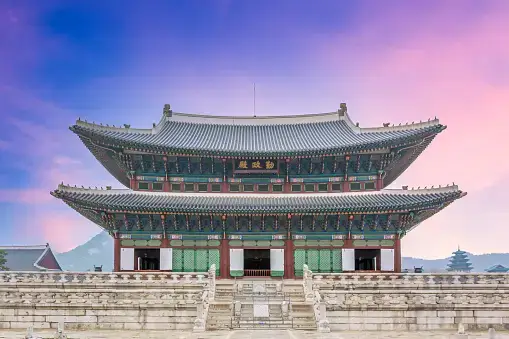Gyeongbokgung Palace (1395)

Title: Gyeongbokgung Palace
Location: Seoul, South Korea
Year of Construction: Originally built in 1395, reconstructed in 1867.
Description: Gyeongbokgung Palace, also known as the "Palace of Shining Happiness," is a magnificent historical complex situated in the heart of Seoul, South Korea. It stands as a symbol of the nation's rich cultural heritage and has been a witness to various chapters of Korean history.
Architectural Style: The palace showcases classic Korean architecture, characterized by its colorful wooden structures, sweeping tiled roofs, and intricately designed gates. The buildings are meticulously arranged to align with the principles of Korean feng shui, creating a harmonious and aesthetically pleasing environment.
Historical Significance: Originally constructed during the Joseon Dynasty, Gyeongbokgung Palace served as the main royal residence and the seat of power for several kings. It was the center of political, administrative, and cultural affairs during the dynasty's rule.
Renovation and Restoration: Gyeongbokgung Palace underwent significant renovations over the centuries, with some buildings reconstructed in the 19th century after being destroyed during wars. Today, it stands as an exemplary showcase of Korean traditional architecture.
Royal Ceremonies and Events: Throughout its history, the palace witnessed various royal ceremonies, including coronations, weddings, and state banquets, further highlighting its importance in Korean monarchy and culture.
Main Buildings: The palace complex comprises numerous halls, pavilions, and gates, each with its unique significance. Some of the prominent structures include Geunjeongjeon Hall (Throne Hall), Gyeonghoeru Pavilion (Royal Banquet Hall), and Gwanghwamun Gate (Main Gate).
National Treasure: Gyeongbokgung Palace is a designated South Korean national treasure, symbolizing the nation's pride in preserving its cultural heritage and historical legacy.
Changing of the Guard Ceremony: Visitors to Gyeongbokgung Palace can experience the "Changing of the Guard Ceremony," a reenactment of the royal guard changing shift, showcasing traditional costumes and military etiquette.
Cultural Events and Festivals: The palace hosts various cultural events and festivals, allowing visitors to experience traditional Korean performances, arts, crafts, and cuisine.
Tourist Attraction: Gyeongbokgung Palace is a popular tourist destination, attracting both local and international visitors who seek to immerse themselves in Korea's vibrant history and enjoy the serene beauty of the palace grounds.
Conclusion: Gyeongbokgung Palace stands as a testament to Korea's rich history, culture, and architectural prowess. With its grand structures, beautiful gardens, and historical significance, it continues to be a source of pride for the nation and a captivating destination for travelers eager to explore Korea's royal heritage.
